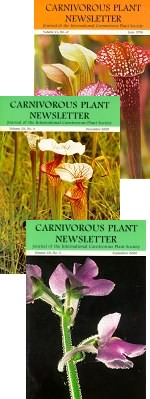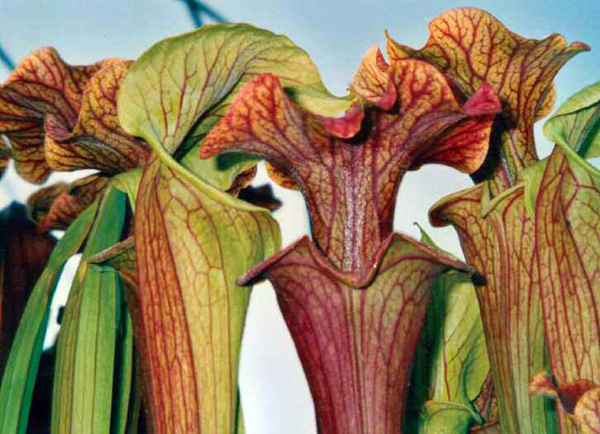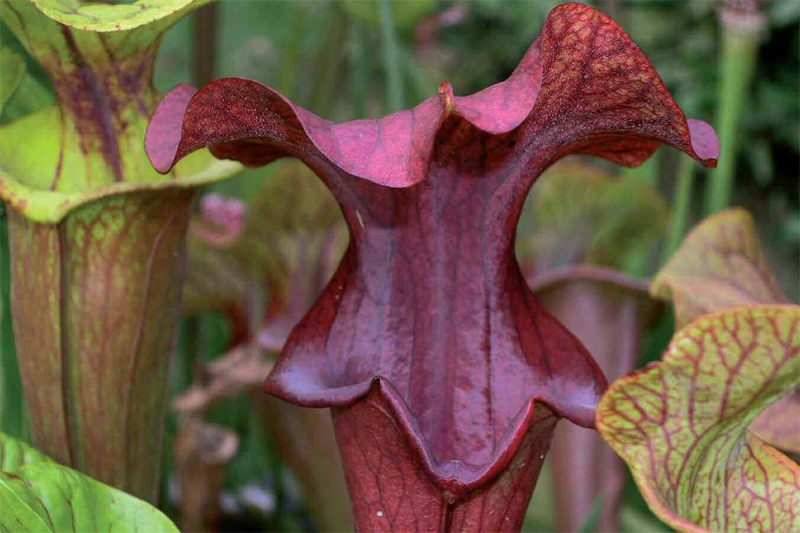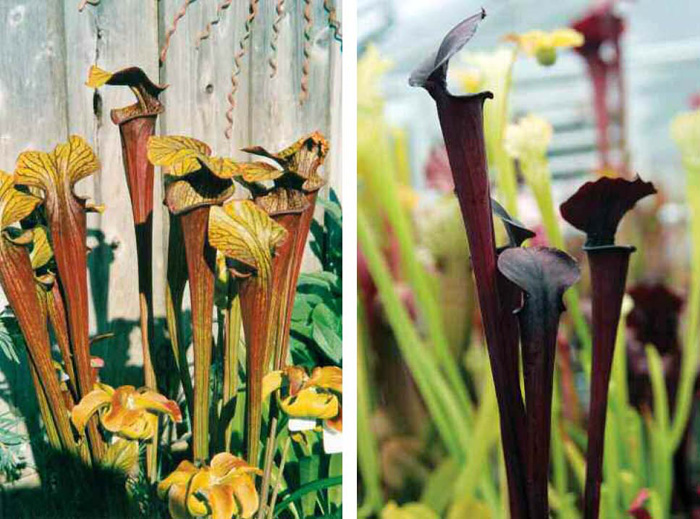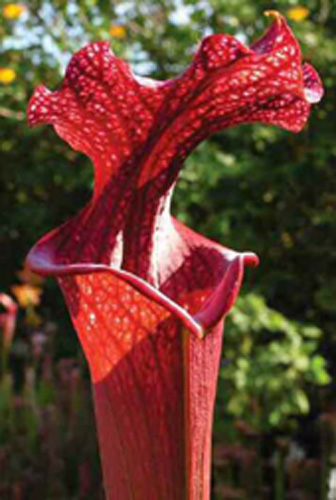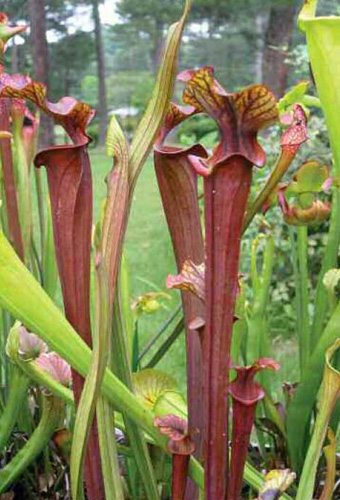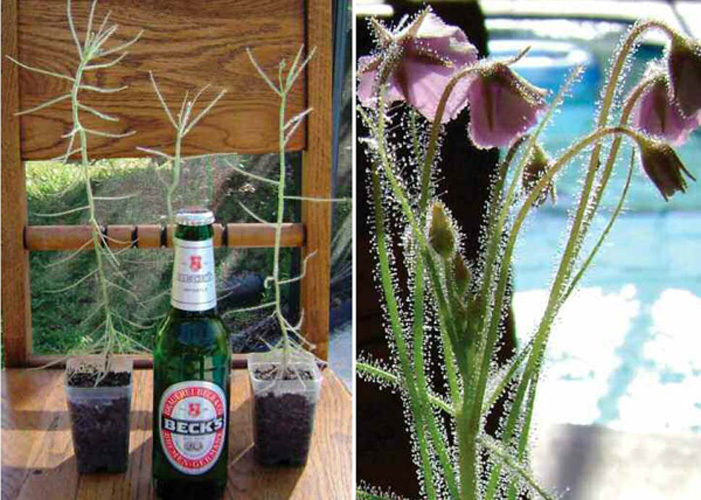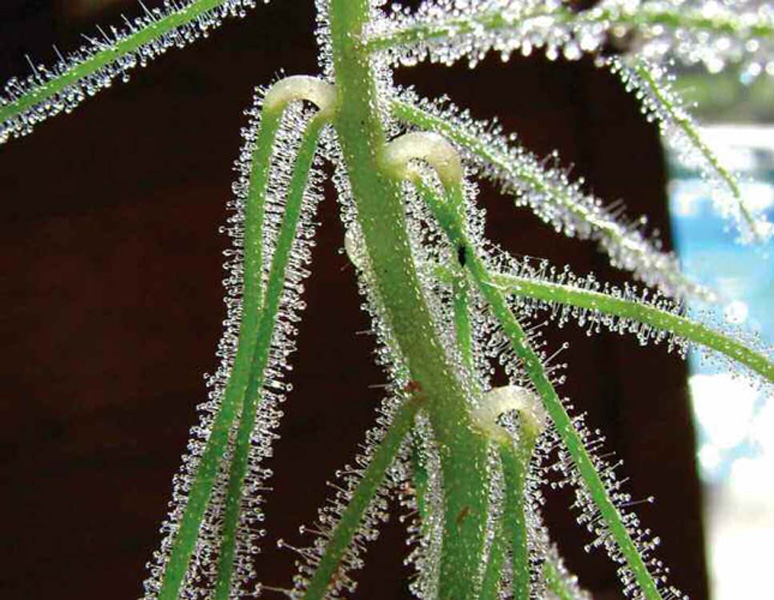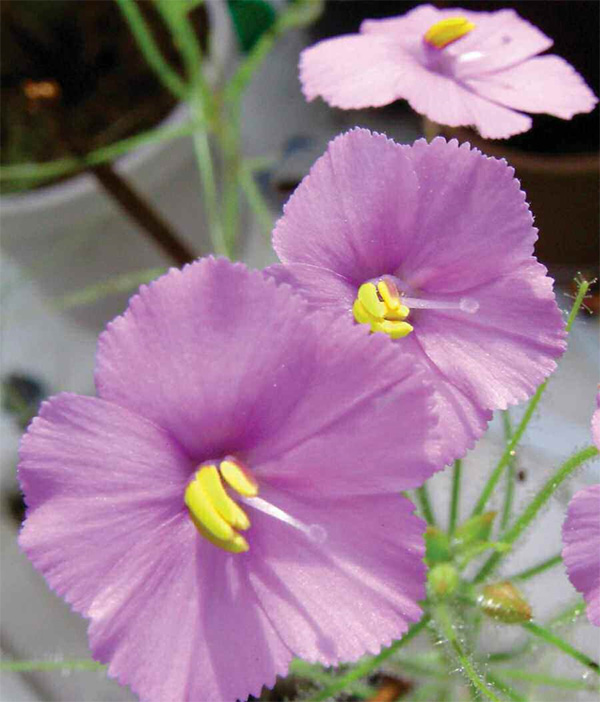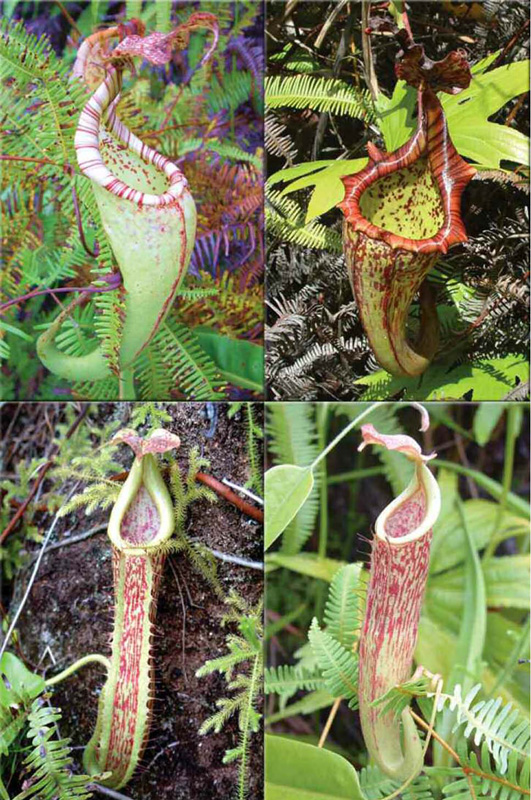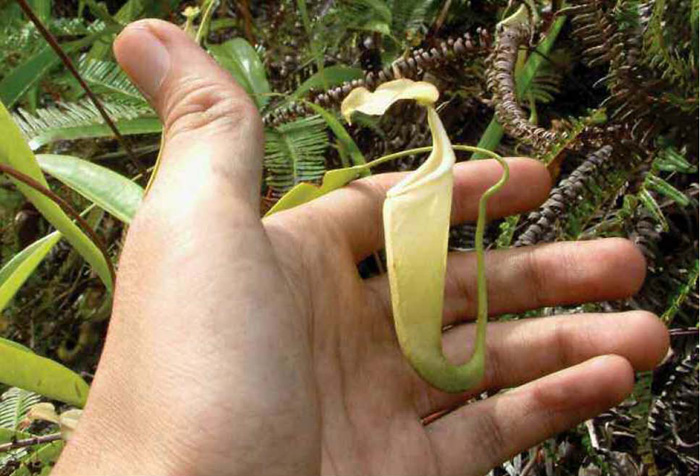
|
| Cultivar Registrations in CPN |
|
Carnivorous Plant Newsletter New Cultivars Sarracenia ‘Reptilian Rose’ Submitted: 2 December 2008 Sarracenia ‘Reptilian Rose’ (see Figures 1 and Back Cover) is a complex hybrid of a clone informally called S. oreophila “Sand Mountain”, with S. ‘Royal Ruby’ (see Figure 4). This hybrid was produced by Phil Faulisi. The specific cross was made in May of 2000 with the seed from this cross being sown in January of 2001. This select plant was chosen and named in May 2004. Pitchers of this plant typically grow 71-86 cm (28-34 inches) in height with a large flaring hood. The early spring pitchers of this plant tend to be more robust, attaining greater size and colouration than pitchers put out later in the season. The pitchers of this plant have inherited the heavy venation from their Sand Mountain S. oreophila parent displaying the trait as the pitchers develop and first open. As the pitcher ages it develops an overall beautiful pinkish-rose colouration. Another characteristic of this plant is that the nectar roll often puckers up in places, creating an almost fanged appearance. This plant commonly produces phyllodia in the fall that are moderately curved in the manner of S. oreophila. The blooms on this plant open a vibrant yellow with a few red markings at their base. Over the course of about a week the petals develop an apricot-orange hue. One thing that we (THW and PF) have both noticed is that the blooms on this plant will occasionally be malformed such that their parts are produced in threes and fours, instead of the usual five. This malformation does not appear to affect the fertility of the specific bloom as both of us have produced seed from such malformed blooms. The unique nature of this plant necessitates that it only be reproduced through vegetative means. The name for this plant derives from a combination of factors. A fellow carnivorous plant grower and colleague of Phil’s, Mitchell Davis, was examining the plant one day and happened to mention that the veining pattern in the throat and inner hood resembled the skin definition of a lizard, hence “Reptilian”. Previously, Phil had discovered that the pitcher hoods were highly fragrant in a manner reminiscent of English roses. In addition, the mature colouration of the pitchers is a deep rose. —TRAVIS H. WYMAN • Stone Mountain, GA • USA
Figure 1: Sarracenia ‘Reptilian Rose’ young pitchers. Photo by Phil Faulisi.
Back cover: Sarracenia ‘Reptilian Rose’ mature pitchers. Photograph by Travis Wyman. Submitted: 2 December 2008 Sarracenia ‘Black Widow’ (see Figure 2 and 3) is a simple hybrid of a S. alata clone informally called “black”, with S. flava var. rubricorpora. It was produced by Phil Faulisi in May of 2000 and the subsequent seed was sown January 2001. The selected plant was chosen and named in May 2004. The clone of S. flava var. rubricorpora used as a pollen donor in this cross (and seed parent in the following cross) was the product of line breeding done by Phil with the intention of producing an extremely dark, all red clone of S. flava var. rubricorpora. Pitchers of this plant average 76-86 cm (30-34 inches) in height. Developing pitchers start out with a base colour of green with very heavy reddish-black veining. Eventually the red-black colour fills in, turning nearly the entire pitcher a deep, shimmering, maroon. As the season progresses the pitcher colours continue to deepen becoming a deep lustrous purple-black especially around the throat and inner hood, an influence from the S. alata parent. The flowers of this plant are a very pale white-cream. This plant should only be reproduced through vegetative means. The name for this plant was chosen because of a fortuitous encounter with a large black widow spider that was found living amongst the pitchers, the colour of the spider’s body was similar to the deep glossy black-purple colour displayed by the fall pitchers. —TRAVIS H. WYMAN • Stone Mountain, GA • USA
Figure 2 (left): Sarracenia ‘Black Widow’ early pitchers. Photo by Phil Faulisi. Submitted: 2 December 2008 Sarracenia ‘Royal Ruby’ (see Figure 4) is a natural S. ×moorei hybrid collected from northern Florida in 1991. Phil Faulisi obtained the plant in 1992. Even before the pitchers are fully developed and open they display a distinct pink flush that deepens as the pitcher matures. Overall the lower portion of the pitchers is coloured a deep olive-green while the upper portions are suffused in lush pink/red raspberry tones. The quality of this colour is best described as luminous or iridescent, and often makes clusters of pitchers appear to glow. Under intense light this raspberry colour can suffuse the upper three-fourths of the pitcher but more commonly it dominates the upper half to upper third of the pitcher. This plant shows a high degree of the S. leucophylla influence in the shape of the hood displaying significant ruffling. Likewise, fenestrations on the hood and upper regions of the pitcher expose the S. leucophylla influence in the cross. The pitchers of S. ‘Royal Ruby’ typically grow 76-86 cm (30-34 inches) in height, but pitchers over 107 cm (42 inches) in height have been observed (PF). The flowers are bi-coloured, the petals being predominantly red with orange/yellow tips. This plant must be reproduced only through vegetative means to ensure that its unique nature is maintained. The name ‘Royal Ruby’ was chosen by Phil in May 2004 because of the regal beauty of the plant and how the colour is similar to that of Burmese rubies. S. ‘Royal Ruby’ was previously distributed by Phil as S. ×moorei “Big Red”. —TRAVIS H. WYMAN • Stone Mountain, GA • USA
Figure 4: Sarracenia ‘Royal Ruby’. Photo by Michelle Meeks. [NOTE: Photo credit corrected. Credit published in CPN was in error.] Submitted: 2 December 2008 Sarracenia ‘Alucard’ (see Figure 5) is a complex hybrid of S. flava var. rubricorpora × S. ‘Royal Ruby’, and was produced by Phil Faulisi. This cross was made in May of 2000 and the subsequent seed sown January 2001. Numerous offspring of this cross display the same character and traits described herein. In structure the pitchers are similar to those of S. flava though the hoods tend to display a slight degree of ruffling alluding to the presence of S. leucophylla genes in the mix. Pitchers average 76 cm (30 inches) in height but can grow to 94 cm (37 inches) tall. Under extremely high light and, most notably, under very bright greenhouse polycarbonate, the pitchers will turn a near complete deep reddish-black over their entirety. The hoods of some pitchers will occasionally show slight green patches, but this is not consistent within or between plants with some plants displaying many green-patched hoods one season and, few the next, while others will produce pitchers with the same lid type season after season and then suddenly revert to the opposite type. As the pitchers age, most turn a complete velvety black, very similar to the colour of cultivated “black” calla lilies. The flowers are yellow. Vegetative reproduction of these plants is recommended and preferred, however any offspring resulting from the crossing of a heavily red S. flava var. rubricorpora pollinated by S. ‘Royal Ruby’ that display the same black pitchers would also be considered to be S. ‘Alucard’. The name Alucard is Dracula spelled backwards and was chosen because the appearance of this plant gives the impression of a dark ominous presence hovering over other accompanying pitcher plants when grown communally in bogs/grouped pots. The name was selected May 2004. —TRAVIS H. WYMAN • Stone Mountain, GA • USA
Figure 5: Sarracenia ‘Alucard’. Photo by Travis Wyman. Submitted: 13 June 2008 In 2007, I received five seeds of “Byblis filifolia” from Australian sources. I did so much trading that year that, I must admit I do not remember the exact source of these seeds. The seeds were sown on fine milled sphagnum, treated with a small grass fire, and then the pot was left well-lit and moist. I was surprised when germination occurred within five days! The seedlings were extremely vigorous and greatly resembled Byblis liniflora until they were about 8 cm (3 inches) tall. The growth rate dramatically increased at that point. The stem elongated and internode distance increased rapidly (see Figure 6). During the next three months, they grew up to 4 cm (1.5 inches) a week. In time, specimens grow up to 1 meter (3 feet) tall! Plants can reach maturity in five months and produce flowers in showy masses (see Figure 7 and Front Cover). The flowers open at first light and promptly close by 4 p.m. To produce seed, the flowers must be cross-pollinated. Flowers will not self-pollinate, nor will pollen from different flowers on the same plant be successful. The flowers will last for about a week if not pollinated. Upon successful pollination, a flower takes on a slight bluish tint and then the petals drop off after three days. The petals are fused, even after petal drop. What happens next truly makes this Byblis variant unique. On the third day, the base of the pedicel changes character. It swells, elongates, and reflexes downward. It also becomes somewhat pale and transparent. The once-erect flower stalk is forced towards the ground as its ripening seed capsule develops (see Figure 8). The pedicel swelling is similar to structures on the base of legume stems, which are called pulvini (singular: pulvinus). Turgor pressure changes in the pulvinus of the “sensitive plant” (Mimosa pudica) is what causes that plant’s leaves to droop when disturbed. The entire process of changing direction from upright to furthest downward takes five to six days. I have determined that the pedicel appendages are geotropic. This was achieved by bending the top half of the plant over to an upside-down position immediately following pollination of several flowers. The pedicel appendages still formed and pointed down to the ground, regardless of its position. Seed capsules are slow to ripen and dehisce in four to five weeks. I made another interesting discovery about these Byblis plants in late October, 2008. The plants have a smell which reminds me of a sweaty, musty shirt that has been worn a few times without being washed. The smell is strongest near the center and the bottom of the plant, and the growth tip and flowers are completely odorless. What is more, the plants exhibit almost none of this smell until they are disturbed—a shaken plant changes from being only slightly smelly to quite pungent in only a few minutes! I think this smell may function to either repel herbivores or attract prey. Another amazing thing about this variant is that it roots easily from cuttings, with an 80 to 90% success rate. The cuttings root in two to three weeks and exhibit the same traits as the parents. Live sphagnum works best as a rooting medium. When well rooted, the plants prefer to be moved into a half sand/half peat mix. They like a medium that is wet, but not oversaturated. I use tall pots at least 13 cm (five inches) wide per plant, to accommodate the many long fibrous roots. The main stem on the parent will branch many times. Mass amounts of shimmering plants can be produced in no time. If the plant is cut back more than half way, several growth points will appear along the older axils of previous leaves. After their massive flowering cycle is over, the plant becomes exhausted, and it declines and ultimately dies. Although I have kept these annuals alive past this point, they are usually so tall, weak and unattractive that I usually let them go to carnivorous plant heaven! By this time, they have usually each given me many plants via cuttings and lots of seed as well. Of course, I have wondered what species this is. It shows the long internode growth habit of Byblis filifolia, but combines the reflexed pedicel of Byblis aquatica. After a few conversations with Jan Schlauer, who I graciously thank for his assistance, I theorize that there is a possibility of this plant being a naturally occurring hybrid between the two species. I have spoken with several other growers of Byblis filifolia, but they did not notice any reflexure of the flower pedicels on their Byblis filifolia plants following successful pollination. The flower pedicels on their plants remained straight up, as with Byblis liniflora. I plan on researching this in much greater depth, of course, and keeping everyone updated on my success. In order to give this plant a name that can be easily used by other horticulturists and scientists, on 9 June 2008 I coined the cultivar name Byblis ‘Goliath’ for the plant. This name is appropriate for two reasons. In the Bible story, Goliath was a massive giant who was challenged and defeated by a sling-wielding David. Growing up to three feet tall, this cultivar is a giant indeed! Furthermore, the downward reflexing pedicels with its seed capsules remind me of David dangling his stone-laden sling to kill the giant Goliath. It is evident that this Byblis ‘Goliath’ truly stands above all the rest! —Brian Barnes • Longwood, FL • USA
Figure 6 (left): Young Byblis ‘Goliath’ plants.
Figure 8: The bizarre, pale reflexing organs that bend the fruit towards the ground.
Front cover: Byblis ‘Goliath’ plants. Photograph by Brian Barnes. Submitted: 29 August 2008 Nepenthes maxima Reinw. is currently defined as a species native to the islands of Sulawesi, New Guinea, and the Maluku Islands. In the past, some folks have also combined plants from Borneo into their concept of N. maxima; but most people now consider these to be separate species: N. fusca Danser, N. hurrelliana M.Cheek & A.L.Lamb and, more distantly, N. stenophylla Mast. and N. chaniana C.Clarke, C.C.Lee & S.McPherson, and N. fallax Beck. However, I remain unconvinced N. eymae Shigeo Kurata is a species separate from N. maxima. This article focuses on a miniature variation of N. maxima, endemic to the lowland areas near Danau Poso (Lake Poso) in Central Sulawesi, Indonesia. Danau Poso is in a lowland area, surrounded by hills and mountains. Many visitors have reported seeing miniature N. maxima in the lowland areas directly adjacent the lake. Over the years, some of these miniature plants were collected and brought into cultivation during the late 1970s through early ‘80s (Rich Sivertsen, Phill Mann, personal comm., 2007). They maintained their small stature consistently, despite being cultivated side-by-side in the same manner as other clones of N. maxima for several years, in some collections, for more than a decade (Rich Sivertsen, personal comm., 1999, 2008). In this article, I establish the cultivated variety name N. maxima ‘Lake Poso’ to discuss these miniature plants. The main difference between Nepenthes maxima ‘Lake Poso’ and the more typical expression of N. maxima is the stature of the entire plant. Nepenthes ‘Lake Poso’ is generally about 1/4 to 1/2 the size of most of the other N. maxima varieties. As per Danser (1928), the type variety has climbing stems with leaves, “usually 15 to 30 cm long by 2.5 to 7 cm broad”. However, in N. ‘Lake Poso’ the diameter of the rosette (without tendrils and pitchers) of the cultivated plants has varied from only 20 to about 32 cm. The leaves of N. ‘Lake Poso’ are usually 8 to 16 cm long by 1.5 to 3 cm broad making the leaf surface area about 1/4 the size of leaves on normal or average sized N. maxima plants. The pitchers are correspondingly much smaller as well and most often the peristomes of the pitchers do not seem quite as wide as one might expect from N. maxima, although the peristomes of the upper pitcher can be well developed. In cultivation, the stems can reach lengths of a few meters, but the diameter is reduced, giving the plants a more gracile or slender and somewhat wiry appearance as compared to most other forms and varieties of N. maxima. This variety shows more tolerance for warm weather as compared to several other widely cultivated varieties or expressions of N. maxima. In January 2008, Alfindra Primaldhi and Muhammad Apriza Suska went on an expedition to explore Danau Poso and surrounding areas with the intention of studying the native carnivorous plants. They visited two locations where Nepenthes maxima ‘Lake Poso’ occurs and Alfindra kindly provided us with photographs and more information about the wild plants (see Figures 9 and 10): These small plants have thinner and somewhat shorter stems. The height of flowering plants only reach about 2/3 the height as compared to normal Nepenthes maxima. The only N. maxima plants that grow near Lake Poso (485 m a.s.l.) are Nepenthes maxima ‘Lake Poso’; this diminutive variety grows in the hillsides to an elevation estimated to be about 1200 m. The nearest normal sized N. maxima are found further away, 10-15 kilometers north and south from Lake Poso in highland areas above 1,600 meters. The closest normal sized N. maxima were found over 1 kilometer past the last of the small plants. We have two theories regarding the origin of this variety: 1) Natural variation within Nepenthes maxima caused by local environmental pressures we do not understand. Some animal populations respond to being trapped on small islands by becoming smaller in stature (pygmy deer and alligators of Deer Key, Florida, USA). Perhaps the small lowland areas adjacent Danau Poso induced a similar evolutionary reaction in locally abundant N. maxima. 2) The Danau Poso area populations of N. maxima absorbed another species of small stature, possibly N. gracilis Korth. during ancient times. While discussing this, Alfindra mentioned that the closest known location for N. gracilis is over 100 kilometers to the south and Danau Poso is surrounded by mountains and other highland areas, making it very unlikely N. gracilis could migrate into the area. While this is true now, I suspect the climate may have been significantly warmer in the past, possibly warm enough for N. gracilis to have colonized the Danau Poso area. Alfindra and M. A. Suska also found a third miniature population at 1,600 meters where N. maxima grows along with N. glabrata Turnbull & Middleton and Drosera burmannii Vahl (Primaldhi 2008). It is not clear if these dwarf, highland N. maxima plants should be included into the concept of N. ‘Lake Poso’. Alfindra states, “From my personal opinion, it reminds me of the miniature N. maxima found around Anggi Lakes in Papua. Please review the photographs and notes from that area by Dr. Andreas Wistuba.” Alfindra distributed seed of this variety labeling it, “mini-maxima 1,900 meters” (the 1,900 meters was a transcription typo and was actually 1,600 meters altitude). If these plants also show warm weather tolerance in cultivation, they can be included in N. ‘Lake Poso’, unless they demonstrate some other morphology, like the adult plants no longer being significantly smaller, gracile and wiry in appearance. The larger, wavy leaved form of N. maxima can also be found in the highlands around the lake; on this expedition it was found at a location measured at 1,900 meters altitude, a little over one kilometer past the last of the small plants. In April, Alfindra, Muhammad and friends visited another location (which is scheduled to be cleared for development), this time in New Guinea where a miniature Nepenthes maxima was found growing with N. klossii Ridl. at 1,700 meters altitude. Several plants with intermediate morphology were found and these are most likely hybrids between the two species. Alfindra says these “mini-maxima” appear more similar to the plants found at 1,600 near Lake Poso as well as the plants Dr. Wistuba found near the Anggi Lakes, New Guinea (Primaldhi, A. and Suska, M.A. personal comm., 2008). Based on reports by Alfindra and several other Nepenthes explorers, it would seem there are at least several locations where miniature expressions of N. maxima occur and these plants may represent an unrecognized intra-specific taxon. However, it is far beyond the scope of this article to propose any changes in the taxonomy of Nepenthes maxima Reinw. In the case such a change is made, Nepenthes ‘Lake Poso’ might be considered as a selection from this form or variety; although at this point the relationship between Nepenthes ‘Lake Poso’ and other dwarf or miniature expressions of N. maxima is unknown. There are several mature clones of this cultivated variety already in some collections and seed was recently dispersed to several experienced growers. At this point, cuttings are an easy and reliable method to propagate this variety. If female and male clones of N. ‘Lake Poso’ flower concurrently, seed can be produced and labeled as such. Also, more clones can be collected from the lowlands directly adjacent to Lake Poso of Central Sulawesi; provided these match the description of significantly reduced stature and somewhat gracile, wiry appearance. Coloration is not important and will vary from clone to clone, the general shape of the leaves and pitchers can also show considerable variation as is normal for N. maxima. It is entirely possible an all-green or all-red clone could be found in a batch of seedlings or even in the wild. Plants matching the general physical description, but not from near Danau Poso should not be considered N. ‘Lake Poso’. Alfindra collected and distributed seed from two lowland populations of small plants. The first location was at 400 meters and the second at 700 meters altitude; the third, questionable population, at 1,600 meters. The composite photos in the standard are from wild plants of both lowland populations (see Figure 9). Based on Alfindra’s photographs and his description of the plants, we are confident seed collected from these two lowland populations will grow into plants of Nepenthes ‘Lake Poso’. Notice: We prefer only seed be collected from wild plants. Many Nepenthes species are facing tough times, with massive habitat loss mostly caused by human activities like logging and farming. Oil Palm plantations are now a particular concern for many threatened species of plants and animals. When visiting wild locations, please take precautions not to damage the plants or their habitats, and follow all national and international laws as applied to field collection. For cultivation, use a well draining Nepenthes media or soil. This variety is more of an intermediate grower rather than a true lowland plant and can handle a fairly wide temperature range. It does best with warm to hot days and cool nights, but avoid longer periods of cold night time temperatures which ultra-highland plants may favor. This is unlike the more heat sensitive plants from the highlands like the wavy-leaf form which I have found require cool to warm, but not hot, days in combination with cool to cold nights to remain vigorous. Selective breeding can probably produce plants that are even smaller. Good luck. This article would not have been possible without the help of Alfindra Primaldhi, M. A.Suska, Rich Sivertsen, Phill Mann, Henning Von Schmeling, and Thomas K. Hayes. No permits were required for the expeditions visiting the areas around Danau Poso, the Nepenthes klossii location in New Guinea and the collections of seed. References Danser, B.H. 1928. The Nepenthaceae of the Netherland Indies, Bulletin de Jardin de Botanique, Buitenzorg, Serie III, 9(3-4): 249-348. Primaldhi, A. 2008. N. klossii. http://www.lhnn.proboards107.com/index.cgi?board=show&action=display&thread=1774&page=1. Accessed 11/2008. —DAVID P. EVANS • New Jersey • USA
Figure 9: Nepenthes maxima ‘Lake Poso’. Clockwise from top-left: Upper pitcher from 400 m, upper 700 m, intermediate pitcher 700 m, lower pitcher from 700 m. Photograph by Alfindra Primaldhi.
Figure 10: Upper Pitcher from 400 m location, hand included for scale. The pale/cream coloration of this pitcher is very common for upper pitchers of Nepenthes maxima ‘Lake Poso’. Photograph by Alfindra Primaldhi. |

